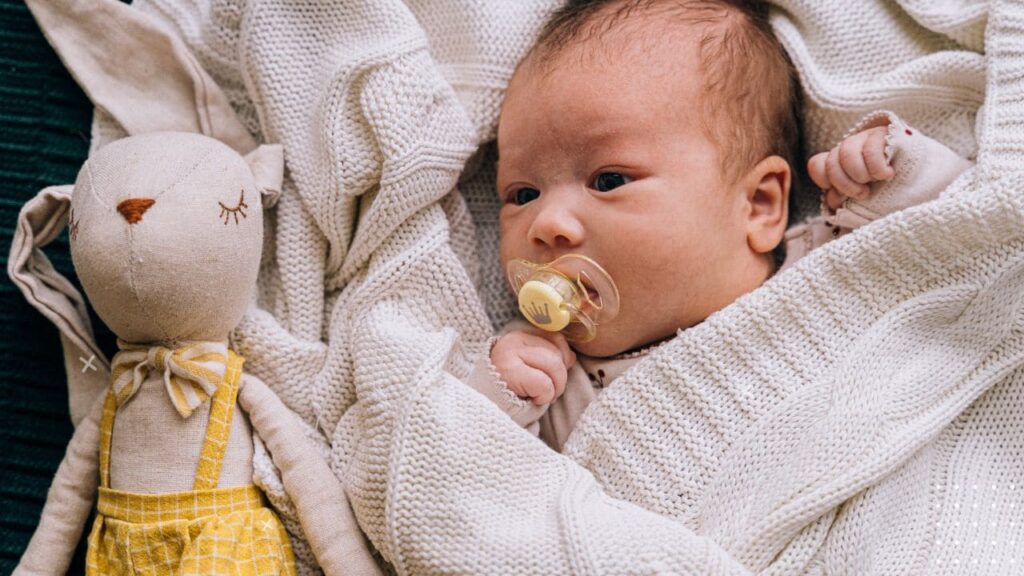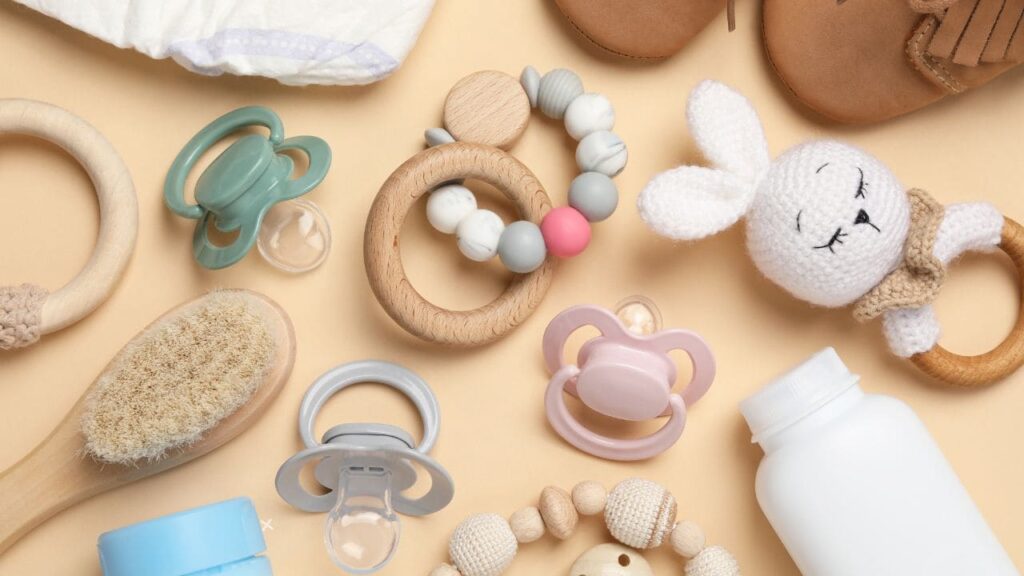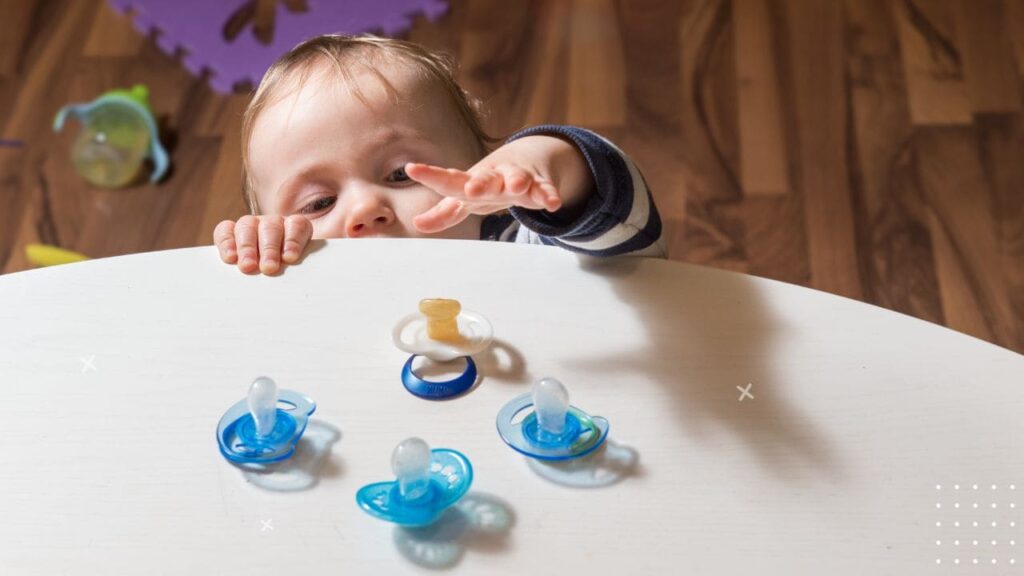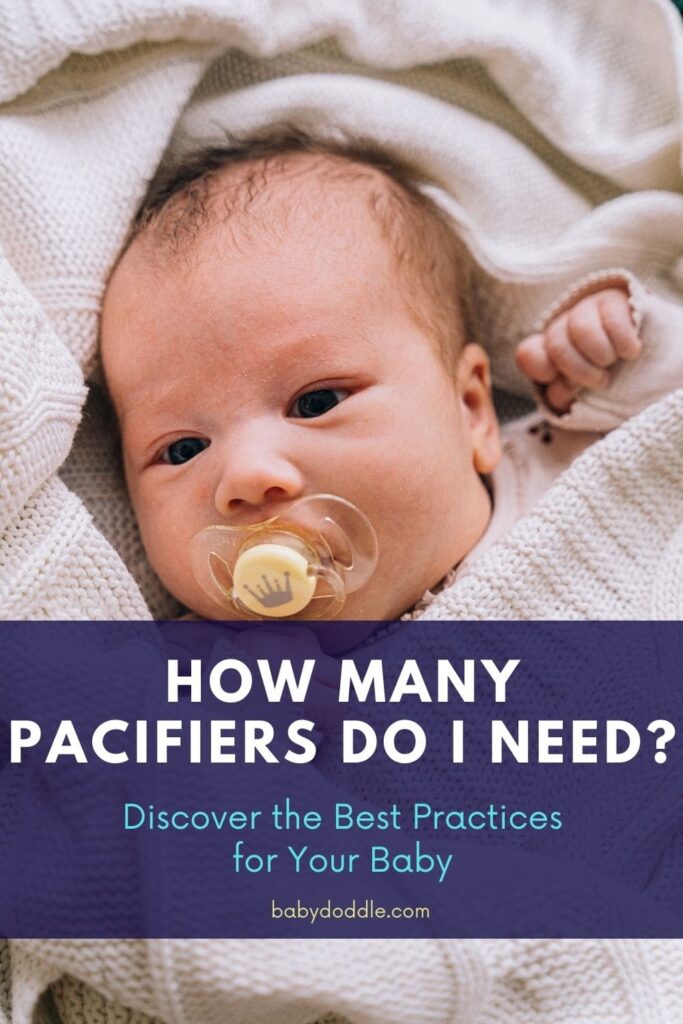As a new parent, few things can be more frustrating than a wailing baby that you can’t seem to soothe. While techniques like swaddling, shushing, and swaying work wonders for some infants, others seem near-impossible to calm without the help of a trusty pacifier. However, questions may arise around how many pacifiers you truly need and what the best practices are for use.
In this comprehensive guide, we’ll tackle the common quandaries parents have about building the right pacifier stockpile. You’ll discover specialized recommendations for quantities based on age, learn the difference between pacifier types, get pro tips for cleaning and care, and figure out the ideal time for weaning. Arm yourself with the knowledge you need to decide how many pacifiers your baby should have handy both at home and on-the-go.

Why It’s Smart To Have Spare Pacifiers
While one pacifier may be sufficient some of the time, relying on a single soother can cause headaches when it suddenly goes missing. The nightmare scenario of a middle-of-the-night meltdown without a replacement baby soother can leave you feeling desperate. Having backup options ensures you always have subs sitting readily on the bench.
Stashing extras throughout the house in go-to soothing spots allows you to seamlessly swap out dirty or dropped soothers. Strategically placing baby calming tools like pacifiers in spots like the crib, stroller, swing, car seat and living room takes preparation off your plate. You’ll never have to scramble searching high and low for a lost lone pacifier again.
Toting additional infant comfort devices in your diaper bag also guarantees you can quickly tend to fussy situations even when out and about. The ability to conveniently plug tears gives you more freedom to enjoy activities like play dates, trips to the mall, and visits with relatives worry-free. While hauling around a whole team of soothers may sound excessive, most parents swear keeping your bases covered with backups brings next-level peace of mind.
ACTION STEP
Conduct an assessment of the key spots your baby spends time both in and out of the home. Place at 2 pacifiers in each location so you always have easy access to a replacement baby essential.
Finding the Magic Number for Your Baby
Of course the lingering question remains – just how many pacifiers should you amass? Recommendations vary based on the unique needs and age of your little one. As babies grow and developmental stages change, you may need to tweak your pacifier quantity based on usage factors. Here’s an at-a-glance guide to tailor stock to your child’s current phase:
| Age Range | Recommended Quantity | Details |
|---|---|---|
| Newborn (0-3 months) | 4-6 pacifiers | Start with 2-4 to determine preference, have extras for home soothing and on-the-go needs |
| Growing Infant (3-6 months) | 6-8 pacifiers | Bump up quantity as mobility increases and dropping/losing pacifiers becomes more common |
| Older Baby (6-12 months) | 8-10 pacifiers | Ensure ample spares as dependency increases nearing toddlerhood, stash everywhere for convenience |
Newborns (0-3 Months) Pacifier Needs
When bringing home a newborn, you’ll want to ensure you have pacifiers on hand to test out but avoid going overboard yet. Start with purchasing 2-4 newborn pacifiers and see if your baby takes to them. Pay attention to when and how long they like sucking and if any styles emerge as clear favorites. This will give you a gauge for how pacifier-dependent your infant will be so you can tweak your numbers up or down.
Around 4 pacifiers should meet needs for solely in-home soothing. If you’ll be tackling lots of outings right off the bat or hope to have baby sleep aids stationed everywhere for convenience, opt for 6 pacifiers instead. This allows you 2 go-to options per typical location.
ACTION STEP
Try both a classic style and orthodontic soother to determine preference then purchase multiples of baby’s #1 pick.

Growing Infants (3-6 Months) Pacifier Needs
As infants grow more mobile during months 3 through 6, dropping, losing, and knocking over pacifiers becomes standard. Hence, the suggested quantity to have in rotation bumps up. Most parents find keeping around 6-8 total baby gear essentials prevents regular chaos. This gives you replacements for when inevitable late-night losses occur and covers both at-home and on-the-go needs.
ACTION STEP
Do a weekly pacifier inventory check and order more if your stash drops below 6 total due to consistent misplacement.
Older Babies (6+ Months) Pacifier Needs
By the time baby passes their half-birthday, juicing up your pacifier count makes sense. Growing infants tend to relish the comfort and soothing these handy tools provide. As babies near toddlerhood around 9-12 months, having 8-10 available ensures you always have a spare.
Stash extras in expected spots like the crib, car seat and stroller as well as around your home for easy access anywhere tears hit. Don’t forget to pack 1-2 in the diaper bag too for tagging along to essential activities and appointments. Restocking once your reserves dip below 8 will prevent you from ever being caught short.
ACTION STEP
Designate a special pacifier basket or bin to keep cleaned spares handy. Check weekly and reorder once your pacifier quantity supply dips below 8 total.
While these age-range suggestions work as a general guideline, pay attention to your individual child. Some babies have less interest in pacifiers altogether while others seem continually attached. Tailor how many you keep around based on actual observed usage but these benchmarks deliver a wise quantity range to start with.

Choosing A Variety Of Pacifier Types And Materials
Rather than stockpiling multiples of the same exact pacifier style, having options on-hand makes sense for a few key reasons. Babies can be particular, meaning what perfectly soothed your firstborn may be fully rejected by infant number two.
Trying a spectrum allows you to determine pacifier shape and pacifier material preferences and have backups in case an original go-to gets lost or damaged. Providing choices also accommodates the possibility that ideal models may change as your child grows. What delights a newborn now may differ from what they fancy at 12 months.
Here are a few varieties worth considering having in the mix:
Popular Pacifier Shapes
- Round Nipple Shape – Classic dome-shaped style. Often best for younger infants.
- Orthodontic Shape – Angled shape designed to support dental development. May be single or multi-piece.
- Petite Shape – Smaller, rounded profile sized for tiny mouths
Top Rated Pacifier Materials
- Silicone Pacifiers – Softer feel many babies love. Easy to sterilize.
- Latex Pacifiers – Lightweight classic material, affordable option
- Rubber Pacifiers – Firmer and durable, less flexible.
Don’t feel compelled to amass every shape under the sun right away. Start with purchasing 2 pacifiers of your top three contender styles to determine what sticks. Once you know baby’s definite temptation, buy multiples of the number one choice while still keeping an additional type like orthodontic on standby just in case.
ACTION STEP
Try a petite, round silicone style alongside an orthodontic soother or vice versa. Observe what gets favored then stock up on 5+ of that preference.
Choosing Between Popular Brands and Models
While having a variety of pacifier shapes and materials on hand is useful, parents will likely gravitate towards one or two preferred brands they love. Here is an overview of some of the most popular models and their unique pros and cons to consider:
MAM Pacifiers
Pros: Come in a wide variety of sizes and shapes to suit any infant, very durable construction, specially designed “SKINSOFT” nipple intended to mimic mom
Cons: Typically more expensive than other varieties, some pieces are not dishwasher safe for cleaning
Best For: Parents who prioritize ultra-soft, flexible nipple feeling closest to the breast
Philips Avent Soothies
Pros: Simple design with few crevices, highly rated and often used by hospitals, rounded nipple shape ideal for breastfed babies transitioning to a pacifier
Cons: Softer premium silicone material means shorter 3-month lifespan on average
Best For: Younger infants, especially satisfying for ages 0-3 months
Dr. Brown’s Pacifiers
Pros: Natural shaped, wide nipple designed for easy latch, ventilation system reduces fluid intake and potential ear infections, cute customizable decor clip
Cons: Multiple piece construction means parts can get lost, nipple is thinner than some and tears more easily
Best For: Great option for babies prone to gas, reflux, or colic as shape allows air flow
Having an overview of the unique advantages of popular picks makes narrowing down the best pacifier for your baby’s needs much more straightforward.
Keeping Pacifiers Clean and Safely Sterilized
When collecting a cache of pacifiers, sufficient storage and regular cleaning enters the chat. Setting up a dedicated system makes maintenance easy while keep extras hygienic.
Cleaning and Sterilizing Pacifiers 101
- Daily: Swish soothers in hot, soapy water between each use.
- Weekly: Use steam/UV/boil methods to fully sterilize pacifiers.
- On-the-go: Pack alcohol wipes or soap solution to quickly freshen.
Storing Pacifiers Properly
- Dedicate a clean tub or basket for housing cleaned extras.
- Use medicine cups with lids to separate individual pacifiers
- Store 2-4 in strategic spots like diaper bag/crib.
- Consider a pacifier pod to connect multiple to stroller.
Don’t let amassing multiples mean cutting corners on pacifier hygiene! Having a system set up makes maintenance a breeze.
ACTION STEP
Get in habit of running used pacifiers through the dishwasher then housing them in a dedicated clean tub after full sterilization weekly.
Determining Ideal Age To Wean from Pacifiers
While your stash can swell significantly that first year, the pacifier party will inevitably come to an end. Deciding when to wean baby from pacifier poses a common conundrum. Here’s what to consider when initiating the transition:
- 12 months + – Ideal time to start phasing out for dental development
- Speech delays – Early weaning if causing talking impediments
- Only pacifies to sleep – Lessen if becoming too dependent to self-soothe without
- Ear infections – Remove if chronic episodes occur from overuse
When you decide to kick the habit, go slowly by limiting pacifier usage to bedtime and naps first. Next, substitute a favorite baby self-soothing tool like a snuggly toy, introduce a lovey or try swapping in “big kid” sippy cups. Moving through changes gradually over 4-6 weeks prevents shocking an attached baby’s system.
ACTION STEP
If hitting roadblocks weaning, make initial bedtime passoffs easier with substitution toys and phase out daytime usage first.
Common Pacifier Accessories and Add-Ons
In addition to the pacifiers themselves, you may want to stock up on some useful accessories to make use and transport easier:
Pacifier Clips
Handy tools that connect your baby’s pacifier to their clothing, blankets or car seat so it stays nearby and is less likely to fall and get dirty or lost.
Pacifier Cases
Special containers that allow you to keep a protected stash of 3-4 cleaned pacifiers in your diaper bag to ensure you have backups when on-the-go. Helpful for preventing loss and keeping soothers hygiene.
Pacifier Sterilizers
Nifty devices that allow you to quickly sanitize multiple pacifiers at once using UV light, steam, or other methods to save time.
Pacifier Holders
Creative gadgets like stuffed animals or creative cases you can attach pacifiers to then hook on car seats, strollers, swings and more to always have access without losing.
| Baby’s Age | Pacifier Transition Tips |
|---|---|
| 6 months | Limit to nap and bedtime usage if overdependent |
| 9 months | Substitute with favorite soft toy for initial bedtime soothing |
| 10-11 months | Phase out daytime and nap usage, only retain for night sleep |
| 12+ months | Aim to fully wean for dental development needs |
Conclusion
Building up a stash of pacifiers takes some legwork but pays dividends when you need to seamlessly swap in spares. Follow best practice guidelines tailored to your baby’s age so you can determine how many soothers truly make sense for your household. With the right routine for cleaning, storage and replenishing supplies, you’ll keep your small fry smiling whether home or on-the-go.
FAQ – How Many Pacifiers Do I Need?
How many pacifier clips do I need?
Target having 2-4 pacifier clip accessories on-hand. Clip one pacifier to clothes near baby’s face for easier access (think bibs, onesies, carriers) then use additional clips to connect pacifiers to strollers, swings and more.
When should I replace worn pacifiers?
Plan to swap out pacifiers every 1-2 months with heavy usage based on pacifier replacement recommendations. Look for cracks, tears or distortion which indicate materials wearing down. Change immediately if pieces detach or present choking hazards.
Can I have too many pacifiers?
While extras are useful, amassing 2 dozen early on is likely overkill. Shoot for meeting benchmark recommendations based on age then tweak as you observe usage. Too many can be tough to constantly sterilize properly!
How many total pacifiers will I need that first year?
Expect to go through at least 12-15 single piece pacifiers the first year as they get frequently misplaced and require replacement. Budget to have 8-10 in current rotation then additional on standby.
What pacifier brands are best?
Top pediatrician-recommended options include Philips Avent Soothies, MAM Pacifiers, Dr. Browns, and Tommee Tippee Ultra. Mix and match to find preferences.












